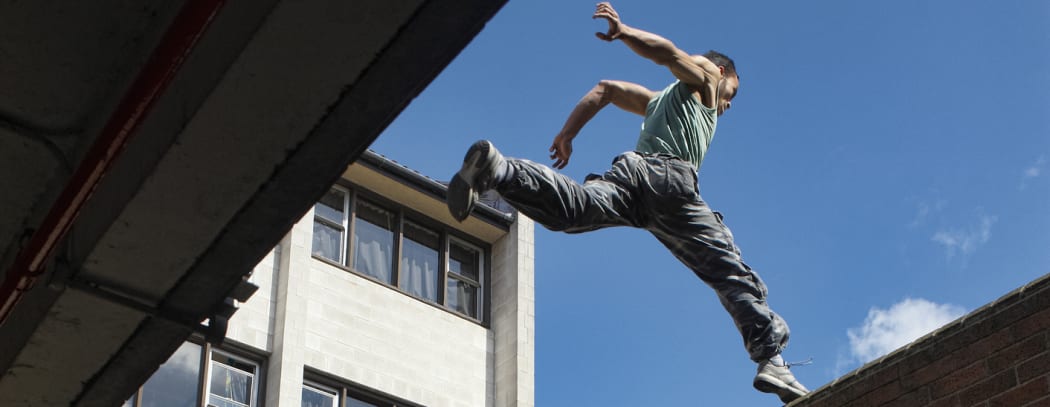


Are you sure you want to reset the form?
Your mail has been sent successfully
Are you sure you want to remove the alert?
Your session is about to expire! You will be logged out in
Do you wish to stay logged in?
On testing the limits of the body and the urban spaces that accommodate it

I am not in space and time, nor do I conceive space and time; I belong to them, my body combines with them and includes them.
—Maurice Merleau-Ponty
When encountering the built environment on a skateboard, writes Iain Borden, the urban landscape is redefined by the skater. He suggests, too, that the skater also undergoes a form of transformation as they traverse – and in some cases transgress – the cities, towns, and suburbs the sport belongs to.
‘Skateboarders recreate both architectural space and themselves into what I call super-architectural space,’ writes Borden. This reimagining or ‘recreating’ of urban space, as he has it, is explored in Skateboarding and the City: A Complete History. The possibility of super-architectural space – a form of accommodation and belonging, whereby personhood and design combine together to transcend their usual, discrete categories – is testament to the innovation of a sport that engages with architecture in surprising and unintended ways.
Skateboarding expands our notion of what Rodrigo Pérez De Arce, in his book City of Play, calls ‘the symbiosis of sport and urban living . . . innate in early modern architectural agendas’ (football, tennis and swimming, for example), as communal foci. The type of play Borden describes, however, began outside – and perhaps, some would even say, in defiance of – the architectural agenda. Media stereotypes of skate counter-culture, at least during the 1990s, were anything but a depiction of ‘the athlete therein impersonating a renovated citizen’.
In her book Dance, Architecture and Engineering Dr Adesola Akinleye, a British dancer, choreographer, writer, and scholar, also questions the extent to which day-to-day urban spaces accommodate us and our behaviours. Like Borden, Akinleye uses athletics (in this instance dance) to explore bodies and buildings as separate, potentially incompatible sites, whose limits can be tested and ‘interrupted’ if not transcended or combined as in Borden’s super-architecture. This is a constant negotiation, Akinleye writes, as she considers, too, how places can accommodate as well as alienate us. This is where her sunrise dance project on London Bridge brings this spirit of negotiation, of moving differently within the public sphere, to bear.
‘This sunrise dance on London Bridge is an artwork’, Akinleye writes, ‘because I have chosen to interrupt the rhythm and have displaced it to find a different relationship with bridge’. For her, as a dancer, the key to this kind of artistic intervention was to think about the bridge spatially rather than temporally, in contrast to the commuter, say, who is less interested in the aesthetics of the bridge than in getting to work on time.
For the commuter, then, rhythm is foremost a singular a possibility for what to do with the bridge – they commute or ‘march’ across it – in order to keep up with the flow of people. Any other relationship with the bridge in this moment, other than this time-sensitive march to work, poses a challenge. Bridges connect places. Yet for Akinleye, whose choreography explores how the body might figure in this relationship, they’re hard to connect with – especially through dance. The irony of her artwork is that, in dwelling on a bridge as a point of connection, the very function of the bridge as a connecting point is disrupted.
Her work playfully highlights the monolithic relationship we often develop we with our cityscapes out of necessity (the rhythm of the commute being just one example). During her sunrise dance, however, the body exists in opposition to ‘the flow’, in opposition to the single possibility of a space and the silent demands we adhere to, often by design. Elsewhere, in Network Nature: The Place of Nature in the Digital Age, Richard Coyne envisages these types of game-like intervention as a means of reintroducing or reimagining nature within the city, from augmented reality to parkour.
If the city is a concrete jungle where dreams are made of, Borden might also concede that it is an obstacle, a man-made impasse. It’s this impasse, after all, which gave rise to skateboarding as a creative response to the urban features – curbs, railings, ramps – that punctuate the built environment. The same is true of sports such as parkour and buildering, which interact with the city as a playable space. (For more on this topic, read ‘The playable city’ by Jenny Roe and Layla McCay.)
Like Akinleye, Bill Marshall is also interested in forms of play and contemporary interruptive urban cultural practice in his highly allusive chapter on ‘Buildering, urban interventions and public sculpture’ for Cities Interrupted. For Marshall, the charms and perils of verticality when free-climbing buildings offer new perspectives on how we’re authorised to move within the city, both literally and conceptually.
‘The beauty of parkour’, writes Marshall, lies in ‘sidestepping the official itineraries of the city and defamiliarizing the objects and obstacles of its fabric’. This not only ‘suggests new pathways [but also] asks questions of that landscape from the point of view of the past as well as the future.’ Invoking the murkiness of daily behaviours at ground level in similar terms to Akinleye, we’re invited to consider what aspects of the city we might want to avail ourselves of, whether completely or at least for a time.
Content linked to in this blog will be free for a month after the post date.
Looking for more? For more architecture content, explore Bloomsbury Architecture Library, and the Architecture Design & Practice collection.
Image credit: Photo by Mike Harrington via Getty Images